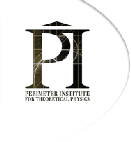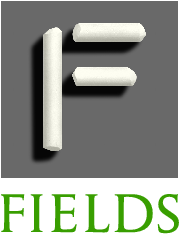Winter Semester 2005
Course on Introduction to Homological Algebra,
Instructor: R. Buchweitz
Course on Symplectic Geometry and Topology,
Instructor: B. Khesin
Mini-Course on Generalized Geometries in String Theory
(at Perimeter Institute) |
Accommodation support is available for participants to the Mini-Course
at Perimeter to stay overnight in Waterloo on the Tuesday or Wednesday.
Please indicate when registering if you require accommodation and for
which dates.
February 15-17, 2005 -- Marco Gualtieri (Fields):
February 15 -17, 2005 -- Yi Li (Caltech):
March 1-3, 2005 -- 11 a.m. Mariana Grana (Ecole Polytechnique
& Ecole Normale Superieure)
Mini-Course: "Toda lattices: basics and perspectives"
(at Fields Institute)
Fall Semester 2004
Course on Mirror Symmetry, Instructor: K.
Hori
Course on String Theory, Instructor: A.
Peet
Mini-Course on Frobenius Manifolds and Integrable
Hierarchies (November 8-12, 2004),
Instructor : Boris Dubrovin (SISSA, Trieste)
Minicourse: "Toda lattices: basics and perspectives"
Speakers: B.Khesin (Toronto), A.Marshakov (Lebedev and ITEP,
Moscow), M.Gekhtman (Notre Dame, IN)
Thursday, March 31, 2005
Lecture 1 - 10:10-11:00
Speaker: B.Khesin (Toronto)
Lecture 2 - 11:10-12:00
Speaker: A.Marshakov (Lebedev and ITEP, Moscow)
Abstract:
We discuss several versions of the Toda lattice, one of the most popular
integrable systems. The first lecture provides the necessary background
and discusses the simplest Toda models along with the necessary tools.
The second lecture describes the rather unexpected appearence of Toda
lattices in the Dijkgraaf-Vafa theory of matrix integrals. The third
lecture (to be given in May) describes integrability of the Toda lattices
on arbitrary orbits and discusses the corresponding open problems.
Friday, May 27, 2005
Lecture 3 - 11:00-12:00
Speaker: M.Gekhtman (Notre Dame, IN)
Abstract:
I will describe basic constructions of the nonperiodic Toda lattice
theory, including interplay between the commutative and non-commutative
integrability and Hamiltonian and graduate behaviour. A particular emphasis
will be put on Toda flows on generic co-adjoint orbits of the Borel
subgroup and integrable lattices associated with so-called minimal Toda
orbits. If time permits, a connection of the latter with biorthogonal
Laurent polynomials will also be discussed. This lecture is the third
part of the minicourse on Toda theory, but starts with all necessary
preliminaries and is completely selfcontained.
Mini-Course on Generalized Geometries in String
Theory (to
register)
Accommodation support is available for participants to the Mini-Course
at Perimeter to stay overnight in Waterloo on the Tuesday or Wednesday.
Please indicate when registering if you require accommodation and for
which dates.
**Note: There is additional shuttle service
available during the mini-courses.
February 15-17, 2005 -- Marco Gualtieri (Fields):
'Generalized geometric structures'
Generalized complex geometry is a unification of complex and symplectic
geometry, and provides a geometrical context for understanding parts
of mirror symmetry. In these lectures I will provide an introduction
to generalized complex, Kahler, and related geometries, and describe
some of their appearances in physics.
Course start times
Feb. 15, 11am
Feb. 16 11am
Feb. 17 11am
February 15 -17, 2005 -- Yi Li (Caltech):
'Twisted Generalized Calabi-Yau Manifolds and Topological Sigma
Models with Flux'
In these lectures, we examine how twisted generalized Calabi-Yau
(GCY) manifolds arise in the construction of a general class of topological
sigma models with non-trivial three-form flux. The topological sigma
model defined on a twisted GCY can be regarded as a simultaneous generalization
of the more familiar A-model and B-model. Emphasis will be given to
the relation between topological observables of the sigma model and
a Lie algebroid cohomology intrinsically associated with the twisted
GCY. If time permits, we shall also discuss topological D-branes in
this more general setting, and explain how the viewpoint from the
Lie algebroid helps to elucidate certain subtleties even for the conventional
A-branes and B-branes. The lectures will be physically motivated,
although I will try to make the presentation self-contained for both
mathematicians and physicists.
Course start times
Feb. 15, 2 pm
Feb. 16 3:30pm
Feb. 17 2pm
March 1-3, 2005 -- 11 a.m. Rm 405, Perimeter Institute
Mariana Grana (Ecole Polytechnique & Ecole Normale Superieure)
'Supergravity Backgrounds from Generalized Calabi-Yau Manifolds'
We will see how generalized Calabi-Yau manifolds as defined by
Hitchin emerge from supersymmetry equations in type II theories. In
the first lecture, we will review the formalism of G-structures, which
is central in the context of compactification with fluxes. In the
second lecture we will see how (twisted) generalized Calabi-Yau manifolds
emerge from supersymmetry equations using SU(3) structure. In the
last lecture, we will discuss special features about compactifications
on Generalized Calabi-Yau's.
Date/Time: Mondays, 9:00 - 12:00
a.m.; start date January 17, 2005 (to
register)
Course on Introduction to Homological Algebra
MAT 1103HS
Instructor: R. Buchweitz
This course intends to give a concise introduction into the concepts
of modern homological algebra and to highlight their applications.
To this end, two hours of lectures will be followed by a one hour
discussion of examples and applications.
Definitions, structure, and representation theorems for Abelian Categories.
Resolutions by projectives, injectives and cohomology theories. Hochschild
Cohomology, Gerstenhaber Algebras, Super Poisson and Super Lie algebras.
Triangulated Categories, exact functors Fourier-Mukai transforms and
other equivalences. Stable theories: Tate cohomolgy, periodicity.
The homological mirror conjectures.
Prerequisite: Core course in Algebra required, interest in algebraic
geometry helpful.
References:
Bass, Hyman . Algebraic $K$-theory.(W. A. Benjamin, Inc., New
York-Amsterdam 1968 xx+762 pp.)
Bourbaki, Nicolas . Algebre. Chapitre 10. Algebre homologique.
(Masson, Paris, 1980. vii+216 pp. ISBN: 2-225-65516-2)
Cartan, Henri; Eilenberg, Samuel . Homological algebra.(With
an appendix by David A. Buchsbaum.Reprint of the 1956 original.
Princeton Landmarks in Mathematics. Princeton University Press, Princeton,
NJ, 1999. xvi+390 pp. ISBN: 0-691-04991-2)
Gelfand, Sergei I.; Manin, Yuri I. Methods of homological algebra.
2nd ed. Springer Monographs in Mathematics. (Springer-Verlag, Berlin,
2003. xx+372 pp. ISBN: 3-540-43583-2)
Hilton, P. J. ; Stammbach, U. A course in homological algebra.
2nd ed. (Graduate Texts in Mathematics, 4. Springer-Verlag, New York,
1997. xii+364 pp. ISBN: 0-387-94823-6)
Mac Lane, Saunders. Homology. Reprint of the 1975 edition.Classics
in Mathematics. (Springer-Verlag, Berlin, 1995. x+422 pp. ISBN: 3-540-58662-8)
Mac Lane, Saunders . Categories for the working mathematician.
2nd ed. Graduate Texts in Mathematics, 5. (Springer-Verlag, New York,
1998. xii+314 pp. ISBN: 0-387-98403-8)
Rotman, Joseph J. An introduction to homological algebra.Pure
and Applied Mathematics, 85. (Academic Press, Inc. [Harcourt Brace
Jovanovich, Publishers], New York-London, 1979. xi+376 pp. ISBN: 0-12-599250-5)
Weibel, Charles A. An introduction to homological algebra.
Cambridge Studies in Advanced Mathematics, 38. (Cambridge University
Press, Cambridge, 1994. xiv+450 pp. ISBN: 0-521-43500-5; 0-521-55987-1)
Date/Time: Wednesdays, 10:00 - 1:00
a.m.; start date January 19, 2005 (to
register)
Topics in Symplectic Geometry and Topology: Symplectic Topology and
Integrable Systems
MAT 1347HS
Instructor: B. Khesin
This is a course on the main notions and basic facts of symplectic
topology. The topics to be covered include: symplectic and contact
spaces, Morse theory, generating functions for symplectomorphisms,
symplectic fixed point theorems (Arnold's conjectures), and invariants
of legendrian knots. We also plan to touch on almost complex structures,
groups of symplectomorphisms, definitions of symplectic capacities
and Floer homology. In the second part of the course we are going
to cover various constructions of completely integrable systems in
finite and infinite dimensions. An acquaintance with basic symplectic
geometry (e.g. covered by MAT 1344HF, Introduction to Symplectic Geometry)
is advisable.
References:
S.Tabachnikov: Introduction to symplectic topology (Lecture notes,
PennState U.)
D.McDuff and D.Salamon: Introduction to symplectic topology (Oxford
Math. Monographs, 1998)
A.Perelomov: Integrable systems of classical mechanics and Lie algebras
(Birkhauser, 1990)
Date/Time: Tuesdays, 1:00 - 4:00
Course on Mirror Symmetry
MAT 1739F
Instructor: K. Hori
Mirror symmetry plays a central role in the study of geometry of
string theory.
In mathematics, it reveals a surprising connection between symplectic
geometry and algebraic geometry.
In physics, it provides a conceptual guide as well as powerful computational
tools, especially in compactifications to four-dimensions.
Outline:
1. Background:
• Supersymmetry and homological algebra
• Non-linear sigma models (NLSM)
• Landau-Ginzburg models
• topological field theory and topological
strings
2. Linear sigma models, moduli space of theories
3. Mirror Symmetry
4. Mirror Symmetry involving D-branes
* B-branes in NLSM - holomorphic bundles, coherent sheaves
* B-branes in LG models - level sets, matrix factorizations
* A-branes in NLSM - Lagrangian submanifolds, Floer homology
* A-branes in LG models - vanishing cycles and Picard-Lefschetz monodromy
References:
The course does not follow a textbook but the following may be useful.
1. K. Hori, S. Katz, A. Klemm, R. Pandharipande, R. Thomas, C. Vafa,
R. Vakil and E. Zaslow, ``Mirror Symmetry'' Clay Mathematics Monographs
Vol 1 (AMS, 2003).
2. P. Deligne, P. Etingof, D. Freed, L. Jeffrey, D. Kazhdan, J. Morgan,
D. Morrison, E. Witten, ``Quentum Fields and Strings: A Course for
Mathematicians'' (AMS 1999).
Date/Time: Fridays, 10:00 - 12:00
Course
on String Theory
PHY 2406F
Instructor: A. Peet
Please see the course website for up-to-date information regarding
the course at:
http://www.physics.utoronto.ca/~phy2406f/
November 8-12, 2004, 4:00 - 5:00 (no
talk Wed., Nov. 10)
Mini-Course on Frobenius Manifolds and Integrable Hierarchies
Instructor : Boris Dubrovin (SISSA, Trieste)
Taking the Institute's Courses for Credit
As graduate students at any of the Institute's University Partners,
you may discuss the possibility of obtaining a credit for one or more
courses in this lecture series with your home university graduate
officer and the course instructor. Assigned reading and related projects
may be arranged for the benefit of students requiring these courses
for credit.
Financial Assistance
As part of the Affiliation agreement with some Canadian Universities,
graduate students are eligible to apply for financial assistance to
attend graduate courses.
Two types of support are available:


